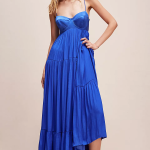- Though research remains limited, some recent findings say that weighted blankets can aid in sleep and reduce anxiety by providing constant gentle pressure, so we tested 11 weighted blankets to find the best ones.
- If you want a full comforter for your bed, our top pick is the Brooklinen Weighted Comforter. If you want to lounge on the couch, you’re better off with the Bearaby Napper.
- If you’re looking for a weighted blanket to help your child sleep better, we have a whole list of kids’ weighted blankets here.
If you toss and turn at night, wake up frequently, or find your mind racing as you try to fall asleep, you might benefit from adding a weighted blanket to your bedding. Usually weighing somewhere between 15 and 25 pounds, weighted blankets provide gentle constant pressure as you sleep, and recent studies have shown promising results in their ability to ease anxiety and reduce insomnia, though research still remains limited.
I spoke with Rebecca Robbins, sleep researcher, author, and post-doctoral fellow at Brigham and Women’s Hospital and Harvard Medical School, and she said the reason why weighted blankets tend to work is actually quite primal. “It really hearkens back to the way we entered the world,” said Robbins. “You were in a womb, compressed on all sides by water and fluid, and so there was a sense of pressure. We try to emulate that with infants, by swaddling them. We might look at weighted blankets as the adult version of swaddling or emulating those circumstances where we feel at ease.”
Prevailing wisdom states that you should purchase a weighted blanket that’s at least 10% of your body weight, but there are a variety of other factors to consider. For more advice on what to consider when buying a weighted blanket, click here or scroll to the bottom of this guide.
I tested 11 of the most popular weighted blankets on the market to determine the best ones you can buy, evaluating them for how well I slept while using them, quality of materials and construction, how easy they were to wash and care for, and, of course, how comfy and cozy they were.
The best weighted blankets in 2021
- Best weighted comforter: Brooklinen Weighted Comforter
- Best cooling weighted blanket: BlanQuil Chill
- Best weighted throw blanket: Bearaby Napper
- Best on a budget: Luna Weighted Blanket
- Best extra-heavy weighted blanket: Gravity 35-Pound Blanket
Prices and links are current as of 1/14/21. We added additional testing notes about the Bearaby Napper and Luna Weighted Blanket.
Jen Gushue/Business Insider
Brooklinen’s Weighted Comforter is a premium quality plush weighted blanket that blends seamlessly with the rest of your bedding.
Pros: Looks just like a normal comforter, lots of plush fill, made of 400-thread-count cotton sateen, has duvet cover loops, accepts returns in any condition within one year of purchase
Cons: Dry clean only, duvet cover sold separately, difficult to adjust while using it
One of the biggest downsides to weighted blankets that I discovered while researching this guide is that design options are limited, and finding one that matches your bedding is no easy task. Over the testing period, I often hid the less pretty ones under my existing comforter, which quickly led to overheating.
If you don’t want to stack blanket upon blanket or compromise your bedroom’s look, you’ll want a weighted comforter, and Brooklinen makes the best one I tried. It looks and feels just like a traditional plush comforter … only with an extra 20 pounds of weight integrated by way of small glass beads. The blanket itself is made of 400-thread-count cotton sateen, and it’s soft enough to throw on your bed without a duvet cover.
That being said, we recommend adding a duvet cover — corner loops make it easy to tie one on — because the blanket itself is dry-clean only, though it can be spot-cleaned and spot-dried with a hair dryer in a pinch. Adding a duvet cover allows you to keep the blanket cleaner longer. Brooklinen sells them separately, but any duvet cover of your choosing will do.
I found that the 20-pound comforter I tested actually weighed closer to 24 pounds, but the extra weight didn’t make too much of a difference once I laid it out on the bed. Sleeping under it was pretty dreamy (excuse the pun). I felt enveloped by the cushy fill, but not too overwhelmed or overheated. I did find that it was difficult to adjust while lying under it due to the weight and size, but I found this to be true for just about every comforter-sized weighted blanket I tested.
Senior editor Jada Wong is also the proud owner of this weighted comforter and after using it for over a year, she still finds it positively impacts her sleep. “I sleep more deeply, my legs are less restless, and my body just feels like it’s getting a big hug for eight hours,” she said.
This blanket is expensive, but considering that it will entirely replace your comforter instead of being an additional blanket on your bed, it’s worth the investment. The biggest downside is that it’s difficult to clean, and if you do need to go the dry cleaning route, a bill for a comforter could run you anywhere from $20 to $50. Though Brooklinen advises against putting it in the dryer, Wong has done to refresh it not and again and it’s held up fine. “It’s still looking great — there are no holes or rips to report,” she said.
Because this comforter is such an investment, you want to make sure it’s right for you, and Brooklinen is not going to stick you with a product you don’t love. The brand has an incredibly lenient return policy, accepting returns for any reason in any condition within 365 days of your purchase.
The best cooling weighted blanket
Jen Gushue/Business Insider
The BlanQuil Chill‘s unique cover disperses heat and stays cool to the touch as you fall asleep, but its slick fabric can cause it to slide off the bed.
Pros: Stays cool to the touch, no beanbag feel, glass beads don’t shift, 60-night sleep trial
Cons: Slides off the bed easily; internal blanket is spot-clean only; only one size, one color, and two weights available
The BlanQuil Chill is the weighted blanket I have the longest relationship with. It’s been on my bed for about a year and a half, and I’ve had two iterations of the design.
I sleep hot, and while the blanket’s cover does an excellent job of staying cool, the side touching your body absorbs heat more quickly. I often found myself adjusting an arm or a leg to find a cool spot on the blanket à la flipping to the other side of the pillow. I lined up all the cooling blankets I tested for this guide and ran my hand across each one and the BlanQuil felt noticeably cooler than all the others, plus it did the best job of “refreshing” itself by dissipating heat and getting back to its cool baseline.
It’s only available in one size, 48 inches by 74 inches, which is just a bit bigger than a twin mattress, and two weights: 15 or 20 pounds. It’s not a blanket that’s intended to be shared, but I drape mine over my queen bed horizontally so both my partner and I can benefit. Glass beads add weight, but there’s no beanbag feeling, and I’ve never felt them shift in a way that causes the blanket to feel lumpy or uneven.
The zipper on the removable washable cover of the first version of the design was quite weak and broke just a couple of months into its use. It couldn’t handle the weight of the blanket and it popped as I was adjusting it on the bed. But BlanQuil has since improved this shortcoming and reinforced the zipper. It feels much stronger now, and I’ve yet to have a problem with it. I even stress tested it by holding the weight of the blanket against the zipper, and it held strong.
One persistent shortcoming that still remains in the new iteration is a consequence of the material used in the cooling cover. The fabric has a bit of a sheen to it and is therefore a bit slick. If you toss and turn at night — which I do, even under a weighted blanket — the blanket will slide off the bed. As soon as it gets off-center, the blanket’s own weight in combination with a lack of friction provided by the cover will cause it to start to slide.
I’ve mitigated this a bit by sandwiching it between my top sheet and my comforter, but it’s still not a reliable fix. Because of this, I debated not choosing this as the best cooling blanket, but none of the other cooling blankets I tested even came close to keeping me cool for as long or as consistently. I’m still on the hunt for the perfect cooling weighted blanket, but I consider the BlanQuil Chill to be the best cooling weighted blanket for now.
The best weighted throw blanket
Jen Gushue/Business Insider
The open-knit construction of the Bearaby Napper keeps you cozy yet cool as you lounge on the couch, it’s entirely machine washable, and it’s one of the heftiest blankets we tested.
Pros: Aesthetically minded design, has significant heft, made from organic cotton, washable and dryable, comes in three weights and multiple colors, 30-day return policy if blanket remains unwashed
Cons: Doesn’t fit in compact washing machines, takes multiple cycles to dry, open weave may catch toes and fingers, heavier than advertised (though this may be a pro, depending on your preference)
Many of the weighted blankets on the market emphasize function over form, often because they have to encase and evenly distribute heavy beads. But in the case of the Bearaby Napper, all the weight comes from the dense organic cotton strands hand-knit into one of the most aesthetically-minded weighted blankets I’ve ever seen.
If you’re not convinced straight-up cotton could be woven into a blanket with significant heft, you’d be sorely mistaken. This is a really heavy blanket — so much so that the blanket I tested, which was advertised as the 15-pound version, actually tipped the scales at 24 pounds. I even contacted the company to verify that they sent me the right item, and they assured me they did.
The Nappers are offered in 15-pound, 20-pound, and 25-pound versions, and each one has slightly different dimensions, so I was able to confirm that mine was intended to be the 15-pound version. It’s not necessarily a bad thing that they’re heavier than advertised — I appreciated the coziness — but it’s something to keep in mind when you order.
A blanket this heavy — and bulky — can be tough to shift around, and if it’s going to live on your couch, it will take up quite a bit of space. As I’ve continued to test this blanket, it became too bulky to keep as a throw on the couch to I shifted it to my bed. It drapes nicely over me and my partner on top of our existing comforter, but the open weave makes it prone to stretching if you need to pull it up in the night. It hasn’t misshapen in any significant way, thankfully.
The open weave of the Napper allowed for plenty of airflow, so it didn’t feel as stifling as some of the other blankets I tested. It’s not quite a cooling blanket — Bearaby does offer one called the Tree Napper that I haven’t tested — but it doesn’t trap heat. The holes in the weave are quite large, though, so if you’ll be bothered by some toes or fingers poking through, you might want to look elsewhere.
The Napper is fully machine washable and can go in the dryer on the delicate setting. I wanted to see how the blanket washed and dried as part of my test, but it didn’t fit in my space-saving apartment-sized washing machine — certainly something to keep in mind if you’re in the same boat.
It’s currently available in eight colors, and Bearaby often launches limited edition seasonal colors as well.
The best on a budget
Jen Gushue/Business Insider
Weighted blankets are typically expensive, but the Luna Weighted Blanket is downright cheap despite being constructed from Oeko-Tex-certified cotton and filled with natural glass beads.
Pros: Excellent quality at a low price; comes in wide variety of colors, sizes, and weights; fully machine washable; Oeko-Tex Certified construction; true to weight
Cons: Thinner blanket than some others on our list
I’ll be the first to admit that most of the weighted blankets on this list are true investment pieces, but Luna bucked the trend by offering an excellent weighted blanket at a wallet-friendly price point. Not only was it the most affordable of all the blankets we tested, but its quality also matched or exceeded other weighted blankets at much higher price points.
I tested the 15-pound queen-size blanket, and the glass beads inside were barely noticeable, producing no beanbag effect. Where many other cheap weighted blankets are loaded with chemicals, the Luna Weighted Blanket is Oeko-Tex Certified, meaning it contains no harmful materials.
The blanket itself is much thinner than some of the others I tested, but in a sea of products known for causing sleepers to overheat, a thin blanket was actually a welcome change. It stayed breathable, and was light enough that I could easily adjust it in the middle of the night. It wasn’t quite as cozy as some of the others, but it’s a great option to layer with your usual comforter or use during the warmer months.
As I’ve continued to test these blankets, the Luna has become a bit of a travel-sized weighted blanket for me. Now that I’ve gotten so used to sleeping with a weighted blanket, I have a hard time going without. I wouldn’t recommend taking it on an airplane — it’s a bit bulky for that — but the Luna is thin enough that it folds up to a size that can easily be tossed in the trunk of my car for road trips.
The 60-inch by 80-inch blanket was a true 15 pounds according to my scale, but that weight was dispersed over a larger surface area than some of the other blankets I tested, making it feel lighter. Speaking more generally, that’s something to keep in mind: you’ll feel more pressure resting under a full-size blanket than a king-size one of the same weight.
Luna’s blankets are available in a huge variety of colors, sizes, and weights from a five-pound kids’ blanket to a 30-pound king-size one. The larger and heavier you go, the most expensive the blankets become, but even the largest and heaviest blanket won’t break the bank. Each blanket comes with duvet loops, so it can be tied into a duvet cover if you prefer, but there are enough color and pattern options to match most bedroom decor.
It’s also one of the easiest blankets to clean that I tested. The entire thing fit into my compact washer-dryer, and was fully dry within one cycle — and I swear, it got softer after just one wash.
The best extra-heavy weighted blanket
Jen Gushue/Business Insider
Gravity’s 35-pound weighted blanket evenly distributes weight across your king-size bed and is perfect for those who need or prefer a blanket with some extra heft.
Pros: Great for those who need a heavier blanket, weight is evenly distributed, no beanbag feel, cover is machine washable, comes in three colors, low profile blanket
Cons: Queen/king size only comes in 35 pounds, cover should be washed before use, too heavy to adjust in the middle of the night, inner blanket is hand-wash only, customers are responsible for return fees
Prevailing wisdom states that you should use a weighted blanket that’s roughly 10% of your body weight, but many blanket brands we tested max out at 25 pounds. So if you weigh more than 250 pounds, you may find yourself struggling to find a weighted blanket that feels sufficiently heavy. Larger blankets, like king-sized ones, also distribute their weight over a wider surface area, so they don’t feel as heavy.
When I first received the Gravity 35-pound blanket and it was folded up in its packaging, I thought it would feel impossibly heavy once laid out on the bed, but I found it to be pretty manageable, even though it was much heavier than recommended for my weight. It did tend to slide down the bed, and I’d often wake up about a foot lower than usual because I was chasing the blanket around through the night. It was simply too heavy to pull up or adjust while laying under it, though someone stronger than me will likely not have this issue.
One strange issue I encountered with this blanket was that the micro-plush duvet cover that it comes with felt oddly greasy out of the package. It left a film on my hands as I tried to smooth it out over the bed. But the zip-on cover is removable and washable, and a run through the wash resolved the issue. The inner blanket is hand-wash and air-dry only, but I can’t imagine hauling such a heavy blanket into and out of a washing machine, so this is probably the most practical way to clean it anyway.
The Gravity blanket is low-profile without any excess fill, so it’s a thinner blanket that won’t add a lot of bulk to your bed. That said, it’s not as plush or cozy as something like the Brooklinen comforter, which does also come in a 35-pound version, though it’s much more expensive.
Gravity’s 35-pound blanket is available in three colors, and it’s the only weight Gravity makes in a queen/king size. The brand also makes “single” size weighted blankets that measure 48-inches by 72-inches. I tested a 15-pound one with a cooling cover and found that it performed well, but there was nothing that made it really stand out from the pack.
How we test weighted blankets
There are several factors I took into consideration while assessing weighted blankets. Aside from general coziness and comfort provided by each blanket, I also assessed things like quality of material, value, weight options, and aesthetics. For example, a blanket that came in more color and weight options beat out a blanket of equal quality that came in fewer options. I also considered things like return policies, sleep trials, and how easy these blankets were to clean.
The following are three tests I ran each blanket through to assess general user experience.
Sleep test: I slept with each of the weighted blankets on my bed for at least three consecutive nights. I noted how well I slept overall and how the blanket regulated my sleep temperature. I also paid attention to how well the blanket stayed in place as I slept and how easy it was to adjust it while laying under it. Part of this test also included making the bed every day. Hauling a weighted blanket is harder than it looks.
Wash test: I washed every weighted blanket or cover that was machine washable at least once to ensure that they held up well in the wash, and didn’t shrink, shed, or otherwise show signs of wear. I noted if the added weight made them more difficult to haul into and out of the washing machine. I also discovered that one of the machine washable blankets was so bulky it didn’t fit into my washing machine. For those blankets that weren’t machine washable, I made note of the care instructions and factored that into the cons of the blanket as I assessed them.
Weight test: I wanted to ensure each blanket was actually the weight it was advertised. To get an accurate reading, I weighed myself and then weighed myself again while holding each blanket, noting any discrepancies in the advertised weight versus the actual weight.
Long-term testing: Though my initial testing period lasted roughly one month, we acknowledge that issues may present themselves with extended use of a product. I have continued to test all of the top picks since this guide was published in November 2020. This guide is periodically updated with new findings and long-term discoveries.
What else we tested
Jen Gushue/Alyssa Powell/Business Insider
- Yaasa Weighted Blanket: The Yaasa Weighted Blanket is a knit-style blanket similar to the Bearaby Napper. The two blankets are the same price, but Bearaby had Yaasa beat when it came to quality. Yaasa’s weave was much tighter and therefore allowed for less airflow, and the material also felt spongier and less cozy than the Napper’s. The Yaasa blanket was also dry clean only.
- Baloo Cool Cotton Weighted Blanket: The Baloo weighted blanket struck a great balance between comfort and cost. It’s not as expensive as the high-end blankets we’re recommending, but it’s not as affordable as the Luna. And its construction and quality felt similar enough to the Luna that we’d rather recommend the one that’s even more affordable.
- Helix Weighted Blanket: The Helix blanket is dual-sided with a white sherpa fleece side and a gray minky fleece side. I found the sherpa side especially cozy, and so did my cat. But it had one of the worst beanbag effects of any of the blankets I tried, and there is only one size and color option available, though it did come in three weights. If this blanket suits your style, it’s a decent buy for an affordable price.
- YnM Weighted Blanket: The YnM Weighted Blanket is Amazon’s number one bestseller in weighted blankets, so we wanted to put it to the test. It’s a perfectly serviceable budget blanket, but the glass beads created a sort of beanbag effect that the Luna did not. Plus, the Luna is even cheaper and made of Oeko-Tex certified cotton, and the YnM is not.
- Gravity Cooling Blanket: Gravity is probably the best-known weighted blanket brands on the market, so I wanted to give them a shot. The blanket itself is well-built and high-quality, but the cooling cover did little to actually cool me off as I slept. It just felt like any other weighted blanket, and didn’t do much to distinguish itself from the other blankets I tried.
- Brooklyn Bedding Dual Therapy Weighted Blanket: Brooklyn Bedding’s weighted blanket is dual-sided with a silky cooling side and a minky textured side, and it was my favorite dual-sided weighted blanket. The silky side stayed cool to the touch and the bumps on the minky side provided a nice sensory option. It didn’t feel beanbaggy and the weight was evenly distributed. But it was only available in one size, two weights, and one dark gray color that severely limited how many home decor scenarios it would work within.
What we’re looking forward to testing
- Bearaby Sleeper: This is the only weighted blanket I’ve discovered designed specifically for couples. While there’s little data available to determine the best weight for a couple to share, Bearaby has eliminated some of that guesswork by weighting the two halves of the blanket differently, allowing you to choose the right weight for each person. This is especially useful if you and your partner are drastically different sizes and therefore would benefit from different blanket weights. The two halves can unzip from each other and become two distinct blankets. Right now, they are sold out, but Bearaby has assured us that they’ll be restocking soon, and we hope to test it once they do.
- Luxome Luxury Weighted Blanket: The Luxome weighted blanket comes with a reversible cover with a plush minky fabric on one side and a cooling bamboo fabric on the other. This allows you to customize your blanket with the seasons. I’m curious to see if this versatility actually makes a difference in how the blanket affects my body temperature. It’s also a nice mid-range option in terms of price, and I’m hoping to add some more affordable options to this guide.
- Slumber Cloud Weighted Blanket: In my ongoing quest to find a cooling weighted blanket that stays put throughout the night, I’m looking forward to testing the Slumber Cloud. It’s made using thermoregulation technology developed by NASA to keep astronauts comfortable in their spacesuits. The technology called Outlast uses small beads that absorb body heat when you get too hot and release it back to you when you get too cold. I’m fascinated by this concept and I’m excited to see if it works.
What weight should a weighted blanket be?
Many weighted blanket brands and sites like Healthline suggest choosing a blanket that’s roughly 10% of your body weight. But Robbins adds that there are no clinically established guideposts for choosing a blanket weight. “It’s hard for the one size fits all approach because we’re all just so unique and have different physiologies,” she says.
This is especially true when blankets come in different sizes. A 15-pound throw blanket is going to feel much heavier than a 15-pound comforter since a larger blanket distributes its weight over a larger surface area. Robbins suggests trying out weighted blankets before purchasing them. If you can’t test weighted blankets in a store, look for brands that offer sleep trials or have buyer-friendly return policies like many of our top picks.
What if I’m sharing the weighted blanket with a partner?
If you’re sharing a weighted blanket with a partner, you’ll likely want something a bit heavier, mostly due to the fact that larger blankets feel lighter than smaller ones. A blog from Layla Sleep advises purchasing a blanket that’s roughly 7.5% of the couple’s combined weight. I reached out to the brand to determine how they established this number and a representative responded, “Most suggestions in terms of weight are based on anecdotal evidence. We also factor in the customer satisfaction data that we have when making suggestions, but ultimately the weight that’s right for any one person will depend heavily on personal preference.”
It’s important to note that this parameter hasn’t been established in any sort of clinical trial or scientific study, so take it with a grain of salt. As long as you’re comfortable and can move freely under the blanket, you should choose the weight that works best for you.
What size weighted blanket should I get?
If you are sharing a blanket with a partner and you both have similar body weights, you’ll want a weighted blanket that covers your entire bed. Many brands, including almost all of our top picks, offer blankets in multiple sizes to fit standard twin, full, queen, and king beds.
Some weighted blankets in these sizes are a bit smaller than typical comforters so the weighted blanket doesn’t hang off the side of your bed too much. Excess fabric that hangs off the side can pull the weighted blanket off-center as you shift around in the night.
If you and your partner are very different weights, consider opting for two smaller separate blankets in a throw or twin size. This way, you can each get the weight that’s most comfortable for you. Plus, you’ll have the added benefit of not having to worry about blanket theft in the middle of the night.
How often should I wash my weighted blanket?
Brian Sansoni, Senior Vice President at The American Cleaning Institute, recommends you treat your weighted blanket like any comforter, washing it once or twice a year, provided it’s covered by a duvet cover that you’re washing monthly. If it doesn’t have a removable cover, the entire blanket should be washed roughly once a month.
Check out our other sleep and bedding guides
Lauren Savoie/Business Insider
Powered by WPeMatico






